Mike Jastrzebski's Blog, page 10
February 16, 2015
How Much Snow?

by John Urban
How deep is the snow? Way deep.
Blowing Snow was the title of my blog post two weeks ago. Seemed we had a lot of white stuff way back then. At the time we were telling friends it was about “three Dachshunds deep.” A week later…maybe three Shelties deep. Now? I would say it’s getting close to three Labs deep.
Who knew it would take a series of snow storms for the greater-Boston area to adopt the metric system – we now measure accumulation in meters. How much snow? Meters. Plural. This winter I feel I’ve done more shoveling than the last five combined, and that’s just the snow I’ve raked off the roof. But rather than whine, I’d like to take this moment to recognize five innovations that have made this challenge a little more manageable.
1. The Snow Blower
This technology goes way back to the late 1920s. Growing-up, we stuck to the low-tech version known as the shovel. No longer. I splurged a decade or so ago and bought a used Ariens that was built to last because that’s what they were doing in 1971 when this came off the production line.

2. 4-wheel Drive Automobiles
Ford tough. Is that what those ads say? Doesn’t matter. It can be a Ford, Chevy, Toyota…just as long as it has 4-wheel drive, you’ll be ready to bust through a snow bank or two.

3. Roof Rakes
It’s a sad admission that we need to rake snow off our roofs, but when it gets deep these long handled rakes are a lot more attractive than getting up on a high perch with a snow shovel.

4. Sorel Sub-zero Boots
Snow plus frigid temps. That’s when you want to start buying clothing that comes from north of the border. Those folks up in the Canadian Provinces know how to keep their feet warm.
5. Ice-Damn Busters
How bad has it gotten around here? It’s come down to this: in an effort to ward off roof leaks caused by ice damns, we’re told to fill nylon stockings with ice melt, chuck them up on the roof, and put them in place – with the trusty roof rake – so that the ice melts a channel that lets water drain off the roof. Does it work? Stay tuned.
So there they are. Five innovations that make this Fargo-like winter a bit more tolerable. Yet, let me end with one more innovation, one that has become even more desirable in the last month.

I believe the advertisement is: “Got to get away?”
Share on Facebook
February 14, 2015
Tick, tock
One of the tiny islands that make up the “necklace” of islands that is Majuro atoll.
by Christine Kling
Things are getting pretty crazy for me here. The past six months have flown by. We will be boarding a plane next Friday and flying back to the states for another merry go round tour of family, friends and events. My son is getting married on the 1st of March in Fort Lauderdale, and Wayne and I are tying the knot on March 21st on a sunset cruise boat in San Diego Harbor. Long flights, hotels, family guest rooms, rental cars — am I going to be able to keep working on this book? We’ll be gone from Feb. 20 until March 30, and my book is due March 23. My deadline is on my honeymoon!
Yeah. Scary, eh? I’d wanted to have a draft in hand by the time we left — five days from now, but clearly that’s not going to happen. I’ve been jamming trying so hard to write more each day — to the extent that last week, I didn’t even write a blog post. At the end of each day for the past several weeks, I have not met my goals for that day. The words just don’t flow out fast enough. My really slow days are 800 words and my best day so far was around 3400 words.
Yes, I could ask my editor for an extension, but I don’t want to. I’m disappointed with my slow output, and I’m determined to prove to myself that I can do this. The last chapters of a book have always gone fast for me. My last two books have been around 130,000 to 140,000 words. Don’t ask me why I am doing this to myself. I’ve just had long stories to tell.
We are not talking about writers’ block. I guess you might say it is idea block. When I can see the scene in my head, the fingers fly on the keys. But until I can see it, I can’t write it. I’ve tried writing nonsense like they tell you to in books about this stuff, but that doesn’t work for me. If I don’t know what is happening next, it’s because I don’t know enough about my story yet. The only thing that brings a scene into focus is learning more. At times, I can accomplish that by writing pages that won’t make it into the novel, but they will increase my knowledge.
Sometimes it’s because I don’t know enough about my characters. I don’t know what is driving them and just deciding that this guy should do something because it fits the plot is not the same as knowing in my gut that this guy would do this because that’s who he is. Maybe I have to research more about the job I’ve given him, or I ask myself who his first girlfriend was or what he was like as a little kid. When I imagine those things, he starts to come alive for me. It doesn’t work to think out loud. I have to write it down.
Other times, it’s that I don’t know enough about the setting — the place where the action is playing out. Yesterday I wrote a scene that takes place in the Roman catacombs. Wayne and I went to Rome last spring, but at the time, I didn’t know my bad guy was going to get obsessed with the Christian catacombs, so we didn’t go take a catacomb tour. But when I got to that part of the book, I realized he wanted to go there. Big problem. I didn’t know enough about what they would look like to picture the scene in my head. I spent several hours doing research and learned fascinating facts. Did you know there are around 60 different catacombs that have been discovered in Rome where the early Christians (like 1st -3rd century) buried their dead in underground tunnels? Most are not open to the public, and they’re now under highways and shopping centers and apartment complexes. Most people don’t even know they’re there. The entrances are closed and locked, but what if . . . .

Barney providing scale for this giant clam shell on shore.
This is why we have been “stuck” here in Majuro (not cruising the outer islands of the Marshalls). I must have Internet to write the kind of research-intensive thrillers I’ve been writing. As an atoll, Majuro looks like a necklace of smaller islands connected by reefs. We like to pick up one of the moorings off the more remote island called Eneko (part of the necklace that is Majuro) where we get good protection. We have peace and quiet and Internet here — everything I need to work. I’ve written three quarters of a novel here over the last six months.
Now, I’m worried about my ability to think and write during the next 5 weeks. Will I be able to tune out the madness to write, and then tune back in to enjoy these special occasions? When we returned to Learnativity last August, I was worried about whether or not I could write on a boat while living with another person aboard. It’s been a big change to go from being a single person and solo sailor/writer to living in a relationship. And it took me a while to find my space and get my head into being able to concentrate with someone else around, but now I’ve proven that I can do that.
Am I going to be able to finish this book on time for the proposed October release? I’m going to miss our little Eneko writer’s paradise. It’s going to be tough, but I am going to damn well try.
Fair winds!
Christine
Share on Facebook
February 13, 2015
Life happens…
c.e. grundler
This is one of those first paragraphs I’ve retyped a dozen times, each time trying to find an upbeat way to spin the fact that I’ve been having one of those craptastic weeks that life throws at us from time to time. As life tragedies go, it’s all small-scale stuff, and it all will pass, eventually. But when you haven’t slept or eaten properly for 48 hours, you start getting a bit wonky.
Let’s start with one cracked molar, all the way back, that I spent the morning at the dentist, remedying. And last night, when I finally felt brave enough to venture a bowl of lukewarm soup, the temporary crown promptly detached itself. So it’s more pain, no more eating for a bit, and back to the dentist this morning.
And to keep my mind off my empty stomach and throbbing jaw, I’ve been on death-watch for days. We took Simba in fifteen years ago, when the cat was already eight and not expected to live long due to a heart murmur. Needless to say, he’s had a good run, but we’re closing in on the finish line. I know, it’s all part of the package – years of love come at a price in the end. And he’s certainly had a full life. And every time I try to write any further, I stall.
Here’s to Simba, to 21 years of kitty life well-lived, and to having happier things to post about in the days ahead.
Share on Facebook
February 5, 2015
Dogs and Brains…
C.E. Grundler
It’s funny when various seemingly unrelated events all mesh together in a unexpected way. It’s something we as writers strive to orchestrate in our fiction, and when reality manages to pull it off, it always comes a surprise — a real-life plot twist of sorts. I’d read a book the other day, and night, and into the next day, a fascinating book where assorted events all led to some amazing discoveries.
How Dogs Love Us: A Neuroscientist and His Adopted Dog Decode the Canine Brain by Gregory Berns caught my eye for two reasons. Since I spend much of my writing inside the heads of questionably stable characters, the inner workings of that grey mush is a subject I find absolutely fascinating. My research library is loaded with books seeking to unravel and understand how the brain ticks. And I’m equally as fascinated with canine behavior. Dogs are and always have been a part of our family, and our newest, unexpected addition, like every dog before her, has brought her own unique talents to the pack.
Emma is scary-smart — she’ll sit and watch everything what you’re doing with this curious, gears-are-turning expression — then try it for herself, usually when no one is watching. This week she figured out those lever-style door knobs and any switch she can reach. She’s teaching the old dogs some new tricks as well — even if they can’t master opening cabinets, they’re only to happy to share the booty. It certainly keeps things interesting. And she has another neat talent, one that’s opening even more doors.
I’d always known about Medical Alert Dogs and I shouldn’t have been surprised, really. It would make sense a dog can sense critical drops in blood pressure. But Emma was sensing it well before I did, (for me, usually but not always seconds before unconsciousness, which does little good by that point,) and once I made the connection, more doors began to open.
For starters, there’s Neurocardiogenic Syncope. Ever heard that one? Neither had I. Turns out it’s the fancy medical word for abruptly passing out when the nerves in the heart get the signal to drop everything, quite literally. It’d be an interesting condition to give a character… but only if you really hated that character. I’ve dealt with this fun condition my entire life, and it’s earned me my share of concussions, which explains a lot if you think about it. Not enough blood getting to the top floor, too many knocks to the noggin…no wonder I’m a bit weird. I’d been to numerous cardiologists over the years, and I’ve been told countless times low blood pressure and a slow heart rate are good things. I get it. Heart disease is skyrocketing, and the majority of the patients they see are struggling with dangerously high numbers. But too low isn’t good. It means if something causes it to dip further, (that’s a fun list, trust me,) I’m out cold. I’ve spent years trying to find an answer, or at least a way of knowing when an episode is coming on so I can find a ‘gravity neutral’ (bed or floor) spot and ride it out.
Enter Emma. Not only was she alerting me to sit down, but as I searched her surprising talent, I discovered she wasn’t entirely alone, and neither was I. All the symptoms I knew only too well were there under conditions I’d never heard — Postural Orthostatic Tachycardia Syndrome — Autonomic Disorders — rare and often mis-diagnosed conditions. I like rare things, though in this case I’ll gladly make an exception. But now I had a direction, and upcoming visits with doctors specializing in this disorder, thanks to my little Feist.
Feist? It’s a term I learned in Gregory Bern’s ‘Dog Project’. His research and radical ideas question the ethical and humane issues involved in animal research, and he refused to subject a dog to anything he wouldn’t himself try, believing any data collected would be worthless if the dog didn’t willingly participate. It’s a fascinating, enjoyably written story, from conception, to “training dogs to go in an M.R.I. scanner — completely awake and unrestrained.” It turned out his own dog, Callie, a so-called ‘Feist,’ was the perfect candidate based on size and trainability. A Feist is defined as “a small dog of uncertain ancestry,” primarily used for hunting squirrel(!) Callie had all the right Feisty qualities, personality and trainability, and she enthusiastically participated. These studies are only in their earliest stages. It’ll be interesting to follow, because there’s a whole lot more going on inside the doggy head than just “Squirrel!” Bern’s ground-breaking findings lifted the rock on much of what what we understand about our best friends, as well as scientifically confirming what dog-owners have always known: Dogs do indeed love us as much as we love them.
Share on Facebook
February 2, 2015
Blowing Snow

by John M. Urban
Winter is here, folks. Snow, cold weather, blistering winds, more snow. Yes, mighty lucky up here in the northern latitudes. We’re a humble people so we don’t want to brag about just how well we have it, but, yes, Mother Nature has once again blessed us with single digit temps and knee deep piles of flakes.
Winter for children is especially wonderful – sledding, snowballs, days off from school. For parents, too. Yes, there’s shoveling, scraping the windshield, and fish tailing turns on the side streets. It’s also good for the economy. We think of it as Mother Nature’s own financial stimulus program with high heating bills, calls to the plumber for frozen pipes, and massive purchases of boots, mittens, and woolen hats. Pretty darn idyllic.
In the last week or so we’ve had somewhere close to two feet come down, which allowed us to glaze-in a good sheet of ice on the roads and sidewalks, followed by another foot-plus of the white stuff today. Without this, we’d be lost. Our doctors would be out of practice in setting broken limbs, Kleenex wouldn’t have the scale of operations to stay in business, and HGTV would crater without the benefit of captive audiences.
Yes, it’s all very grand.
Surprisingly, a few minutes on the Internet shows that our great blessing is minor league compared to some other locales. As much as Southern New England appears to be the new North Pole, there seem to be other areas of this planet graced with even more snow. How lucky are they?

(McKenzie Pass Highway, Oregon)

(Japanese Alps in Honshu, Japan)

(Snow covered house; Lapland, Finland)
The poor souls down in the little latitudes must be jealous as can be. They are probably sitting by the pool right now, ordering-up frozen drinks in a desperate effort to mimic what’s going on up here. Perhaps we should start a collection for those who are stuck in warm weather while they are forced to spend the ends of their days watching the sun set as they dream of escaping to the land of Ariens snow blowers, roof rakes, and ice scrapers.
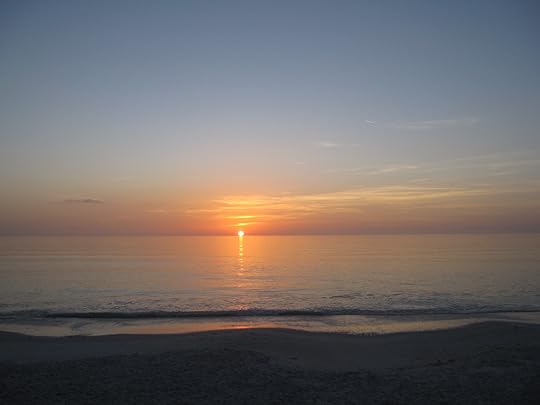
(Southwest Florida Gulf Coast)
Share on Facebook
February 1, 2015
Tracking book sales.
By Mike Jastrzebski
Thanks to Christine Kling I’ve found a great program that allows me to track my book sales going back to 2009. The program is TrackerBox, and I’ve just finished importing my sales from Amazon KDP, Pubit, Smashwords, and CreateSpace. Although it was a little time consuming, I now have all of my sales records going back to when my first book was published in 2010.
The program supports multiple authors and pen names, tracks sales for every title, and charts sales(with or without free books) and income. It also allows export of reports to XLS,PDF,CVS, and HTML, and these are just some of the features.
What I especially like about this is that I have been intending to work up a spreadsheet of all my sales and have just not gotten around to it, now I’m all set.
If you want to give it a try you can get a free 45 day trial. I waited until I had all my sales imported before buying the program, but I think it’s well worth the $59.99 cost.
Share on Facebook
January 31, 2015
Research pays off

In Marsaxlokk harbor checking out the fishing boats
by Christine Kling
With every book I write I always get to a point where I ask myself, “What was I thinking?”
This book is just too hard, too complicated or I’m not up to it or I wanted to stretch but actually I’ve over-stretched. This is beyond what little talent I have. I’m not creative enough to come up with a unique story, and I don’t know anything about history.
You get the gist, right?
That’s where I’ve been for about the last two months — muddling my way through, asking myself why I ever decided to do three different locations in time —not just one, but two storylines in addition to the present day.
The only way I can manage to come up with ideas for these stories is to do my research travel. From the personal experiences I had along the way comes my story. I’m starting to believe I can actually finish this book.
In the new book, Knight’s Cross, I have created two characters, Alonso and Arzella who lived in Malta in 1798. Alonso is a Knight of the Order of St. John and a corsair captain (aka privateer, hence a sailor). Arzella is a silver smith. Actually, she’s the daughter of a famous local silver smith. What the good people of Valetta don’t know is that Arzella’s father has been blind for some time, and she is now making all the famous Jacques Brun silver lamps, teapots, jewelry, et al that they think are made by him. She’s smart, an amazing artist and a kick-ass sailor. I hope my readers will like her as much as I do.
But when I went to Malta last March I had no idea what I would be writing about in this book. I traveled and took hundreds of photos. Even when in the museums, I took pictures of the placards that explained the displays. Now, those photos are helping me to craft this tale.

In the Maritime Museum in Vittorioso I saw this model of a xebec sailing ship, and I loved the look of it and the name. A Maltese fellow we met told us once that Malta is the place where east meets west and north meets south. This boat looks like that.

I liked the story about the Maltese Corsairs even more, and hence Alonso was born.
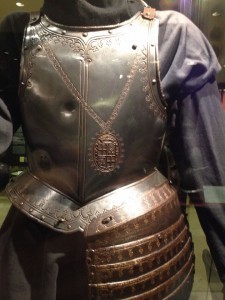 If I’m writing about knights, there has to be some armor, right? That’s what I figured when we went to Valetta, and we visited the Armory in the Palace of the Grand Masters. There were rooms full of weapons and armor, swords and crossbows. I just took photos of as much as I could and now as I write about them, I keep going back to my library of armor pictures. So what if there was something engraved and a piece of armor? Did they do that back then? Back to my photos and I find proof.
If I’m writing about knights, there has to be some armor, right? That’s what I figured when we went to Valetta, and we visited the Armory in the Palace of the Grand Masters. There were rooms full of weapons and armor, swords and crossbows. I just took photos of as much as I could and now as I write about them, I keep going back to my library of armor pictures. So what if there was something engraved and a piece of armor? Did they do that back then? Back to my photos and I find proof.
And for engraving, who better but a master silversmith? I decided Arzella would have to do some work on a shield. Now some shields are in the shape of a diamond, more or less, but I really liked these round ones we saw. So it was off to Google, and I learned they are called “bucklers.” They were gripped by the fist with a handhold on the back, and used by swordsmen.
Then I found one that was very fancy with inlaid gold and made as ornamental armor. How cool, right?

Something like it had to find a place in my story.
I find when I am at my lowest, at that place of self-doubt that all writers go through in every book, that is when my research really pays off. All I have to do is go back into the photo library and start flipping through the pics and within ten minutes, I have a new idea, a new detail that will help to flesh out the story I am trying to tell.
Fair winds!
Christine
Share on Facebook
January 29, 2015
Where to go???
This post is a bit late, mostly because I’ve been so wrapped up in my edits, I’d lost all track of time. It seems the Blizzard of the Century passed me right by, not that I’d notice either way. The pantry’s well provisioned, it’s cold as hell outside, and I’ve got writing to do. I’m in my own little world right now, and the weather there ain’t so great at the moment either, though it’s not quite so cold.
Cold has become the issue, not so much for me as for my husband, who has been dealing with severe Secondary Raynaud’s, where his hands have become excessively sensitive to the cold. (This article gives a good overview.) We’re talking about someone who has always worked with his hands and likes to be outdoors. Now, even temperatures below 60 can trigger a painful episode where his hands lose circulation and movement. This, in a large part, is why work aboard the boat has slowed to a virtual crawl, which only adds to the frustration. I’m doing what I can, but much of the work requires four strong hands, not one 5’2″ human with some fun and interesting heart issues as well. Yesterday I took him for more X-Rays, and last Friday technicians drew vial upon vial of blood for yet more tests to see if there is something else underlying and how to proceed. A few options exist, but first we need a better picture of why this is happening. It’s not something that can be cured, only managed, and top on that list of management is KEEP YOUR HANDS/CORE WARM. And while we’re looking into every avenue of treatment, one thing is becoming clear. It’s time to relocate to a warmer region.
But where? In the thirty plus years we’ve been together, we’d always seen ourselves staying right here in this corner of Jersey, or moving further north, either up the Hudson or somewhere from Rhode Island to Maine. Whenever we traveled, that’s where we’d go, where we know and we like. Beyond cruising, heading south never figured into the equation. But now there’s a new variable throwing that math off, and the compass is pointing us a new direction, to unfamiliar waters.
So, if you were going to throw a dart somewhere along the warmer regions of the east coast, where would you go, and why?
Share on Facebook
January 25, 2015
Out and about in St. Augustine
By Mike Jastrzebski
I haven’t posted in several weeks. Mary works Saturday, Sunday and Monday and those have become my writing days. As a result I’ve been working hard on the rewrites of the new Wes Darling book, Stranded Naked Blues, which is set in the Bahamas. Today I finished my final rewrite and Mary will begin the editing this coming week. She’ll go through at least one and probably two edits.
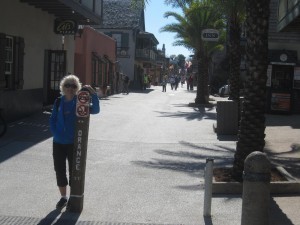
This past week Mary and I did a little exploring in St. Augustine for her birthday. We took the Old Town Trolley around the city and stopped at two very different museums.
First we hit the Lightner Museum.
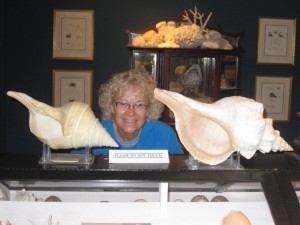
Damn big shells
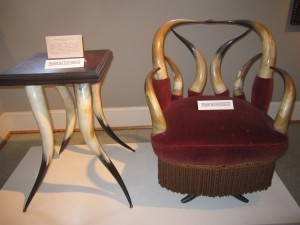
Cow horn furniture
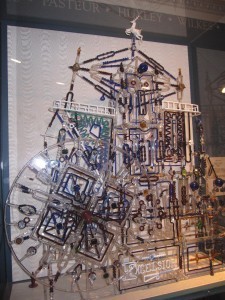 Blown glass engine
Blown glass engine
And then I talked Mary into heading over to Ripley’s Believe it or Not. What a hoot.
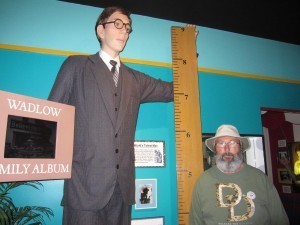 Standing next to replica of the world’s tallest man
Standing next to replica of the world’s tallest man
 Toothpick Cathedral
Toothpick Cathedral
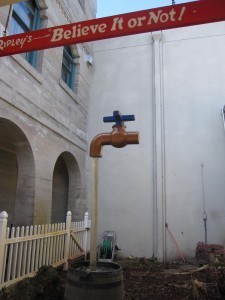 The floating faucet
The floating faucet
After that we went out to dinner and then back to the boat. Overall, despite the chilly weather we’ve been having, it was a very nice day and I was happy to spend it with my wife and best friend Mary on her birthday.
January 24, 2015
Give and take

by Christine Kling
People who dream of going off cruising often think of how great it will be to relax and play all day sipping a cold adult beverage while anchored in the aquamarine water off a tropical island. Okay, there is quite a bit of that in this lifestyle — but for many people only doing that doesn’t lead to a very fulfilling life.
Then there are the cruisers who work at sharing their skills with the local population, whether it’s fixing a fisherman’s outboard motor, guest teaching at a local school, handing out glasses from the Lion’s Club, dentists and doctors providing check-ups, or helping to set up a solar panel and battery array so the island can have ubiquitous Internet not dependent on a generator.
One thing that many who dream of cruising don’t know is that many Pacific Islanders are experiencing severe health problems due to the change from their traditional lifestyle that interaction with the outside world has brought. Of course it’s not just cruising boats that have caused this, but when cruisers find themselves in those wonderful ‘off the beaten track’ places where islanders are living a traditional lifestyle, we need to be conscious of not causing harm.
Here in the Marshall Islands the harm started with the strong American presence after the war. Fifty years ago diabetes was rare in the Marshall Islands. People ate local fruits and vegetables like coconut, breadfruit, taro, pandanus and fish. They walked and got plenty of exercise. Today, there is a diabetes epidemic in these islands: an estimated 28 percent of people over the age of 15 have type 2 diabetes. For those over the age of 35, the figures are closer to 50 percent. At the hospital, the most common surgery is amputation, and studies have shown this is all due to the change from their traditional diet to a diet of processed foods and sugars and a lack of exercise.
There is now a church sponsored Wellness Center next to the hospital in Majuro, and for several years there has been a strong effort to change the local diet from the current donuts, white rice, fried chicken and sugary soft drinks back to more nutritious, high-fiber foods.
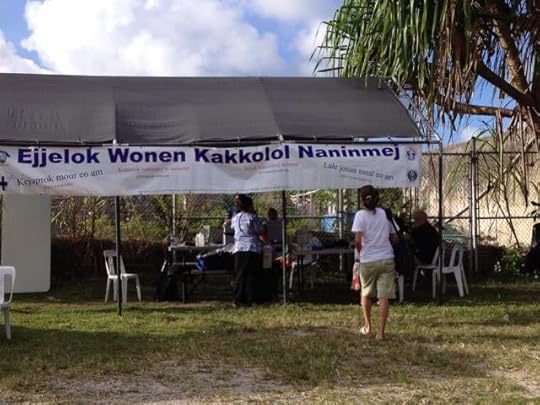
The Wellness Center booth

My favorite lady won us over based on presentation as well as taste!
That’s why on Wayne’s birthday Friday, instead of me cooking a dinner for the captain, we found ourselves tasting and voting at the Mieco Beach Yacht Club’s Chili Cook-Off. For this fun event, the yacht club partnered with the Wellness Center and EZ Price Mart (who provided the tents, tables and the space). There were 11 entries, including the Wellness Center’s own vegetarian chili, another super spicy yummy veggie chili made by a Marshallese lady on behalf of EZ Price Mart (can you tell she got my vote?), and several entries by yachties and other island residents that included green chili, chicken chili, hominy, black bean and garbanzo chilies. The variety was amazing. Across from the chili tasting area, the Wellness Center had a booth set up offering free health check-ups and information on the offerings at the center. The money raised will go toward the yacht club’s Out Island Health Initiative where the catamaran Pogeyan, captained by a physician, takes meds, reading glasses, and sports equipment to the the outer islands as they have for the last 3 years.
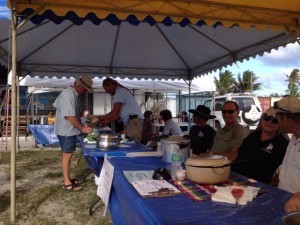 Once again, I am struck by how great it is when cruisers don’t just show up and take from a community by expecting an island to take their trash while the yacht’s crew goes out spear fishing in the island’s local waters. There are some yachts who do that, but thank goodness they aren’t the majority. The majority of cruisers seem to have learned the lesson that, as Wayne often says, the giver gets the gift.
Once again, I am struck by how great it is when cruisers don’t just show up and take from a community by expecting an island to take their trash while the yacht’s crew goes out spear fishing in the island’s local waters. There are some yachts who do that, but thank goodness they aren’t the majority. The majority of cruisers seem to have learned the lesson that, as Wayne often says, the giver gets the gift.
The cruising lifestyle is much more fulfilling when you can think of ways in which you can give as well as take, whether you cruise on a local bay, an inland waterway, or among far flung islands. And it’s not always easy to figure out how to do that in a way that won’t do harm to the local culture or cause the local people to look to yachts only for money and handouts. The Seven Seas Cruising Association refers to this as their clean wake philosophy: “To leave a clean wake is to show respect for others and for our environment so that those who follow in our wake will be warmly welcomed. It is our most cherished tradition.”
As we waddled back to the dinghy, our bellies full of chili, I thought, Kudos to the Mieco Beach Yacht Club! They figured out a way to make feeling full fulfilling.
Fair winds!
Christine
Share on Facebook



